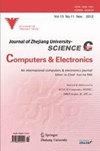Performance study of selective encryption in comparison to full encryption for still visual images
Journal of Zhejiang University-Science C-Computers & Electronics
Pub Date : 2014-06-01
DOI:10.1631/jzus.C1300262
引用次数: 42
Abstract
Securing digital images is becoming an important concern in today’s information security due to the extensive use of secure images that are either transmitted over a network or stored on disks. Image encryption is the most effective way to fulfil confidentiality and protect the privacy of images. Nevertheless, owing to the large size and complex structure of digital images, the computational overhead and processing time needed to carry out full image encryption prove to be limiting factors that inhibit it of being used more heavily in real time. To solve this problem, many recent studies use the selective encryption approach to encrypt significant parts of images with a hope to reduce the encryption overhead. However, it is necessary to realistically evaluate its performance compared to full encryption. In this paper, we study the performance and efficiency of image segmentation methods used in the selective encryption approach, such as edges and face detection methods, in determining the most important parts of visual images. Experiments were performed to analyse the computational results obtained by selective image encryption compared to full image encryption using symmetric encryption algorithms. Experiment results have proven that the selective encryption approach based on edge and face detection can significantly reduce the time of encrypting still visual images as compared to full encryption. Thus, this approach can be considered a good alternative in the implementation of real-time applications that require adequate security levels.静态视觉图像中选择性加密与完全加密的性能研究
由于通过网络传输或存储在磁盘上的安全图像的广泛使用,保护数字图像已成为当今信息安全中的一个重要问题。图像加密是实现图像机密性和保护图像隐私的最有效方法。然而,由于数字图像的体积大,结构复杂,进行全图像加密所需的计算开销和处理时间是限制其在实时中得到更多使用的限制因素。为了解决这个问题,最近的许多研究使用选择性加密方法对图像的重要部分进行加密,希望减少加密开销。然而,与完全加密相比,现实地评估其性能是必要的。在本文中,我们研究了在选择性加密方法中使用的图像分割方法,如边缘和人脸检测方法,在确定视觉图像的最重要部分方面的性能和效率。通过实验分析了选择性图像加密与全图像对称加密的计算结果。实验结果表明,与完全加密相比,基于边缘和人脸检测的选择性加密方法可以显著减少静态视觉图像的加密时间。因此,在需要足够安全级别的实时应用程序的实现中,这种方法可以被认为是一种很好的替代方法。
本文章由计算机程序翻译,如有差异,请以英文原文为准。
求助全文
约1分钟内获得全文
求助全文
来源期刊
自引率
0.00%
发文量
0
审稿时长
2.66667 months

 求助内容:
求助内容: 应助结果提醒方式:
应助结果提醒方式:


